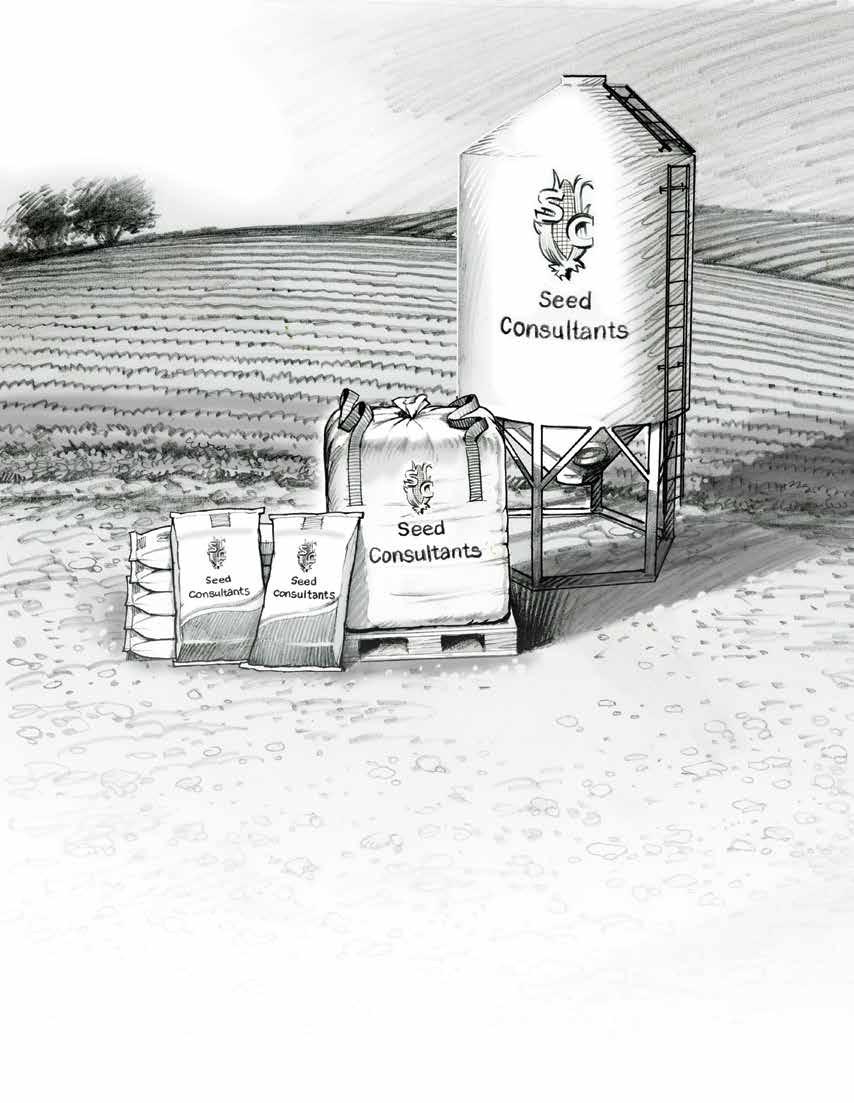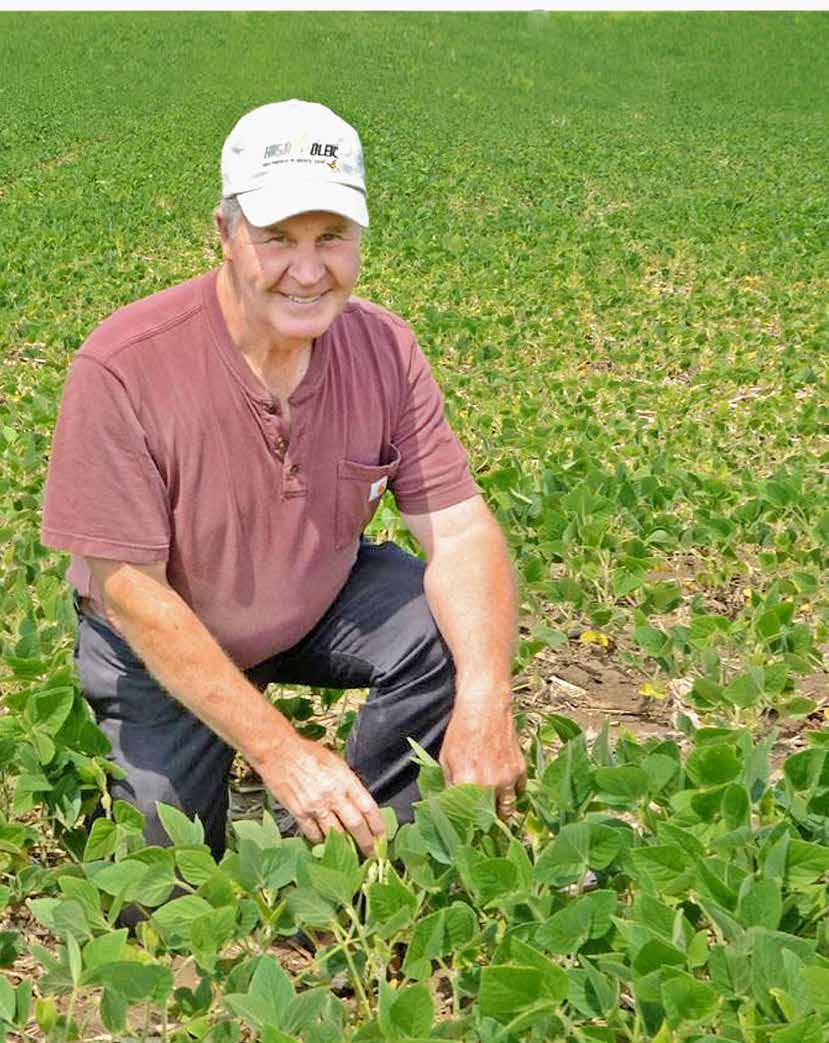
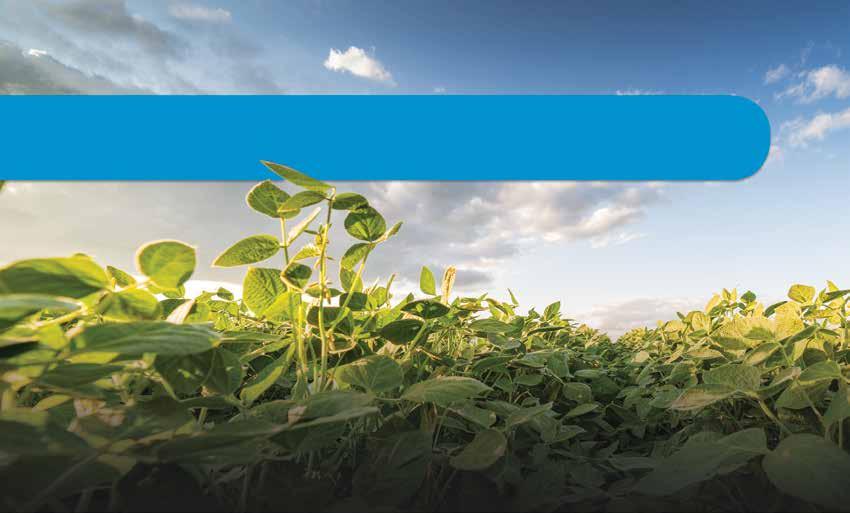











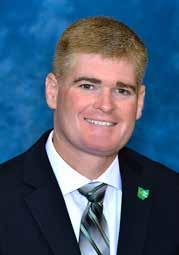
Adam Graham
Ohio Soybean Association Chairman Logan County soybean farmer
Since its founding in 1966, the Ohio Soybean Association (OSA) has worked to be an authentic advocate for Ohio soybean farmers at the Ohio Statehouse, as well as in Washington, D.C. in partnership with the American Soybean Association. In 2016, we celebrated 50 years of successes that have led to increased profits for Ohio soybean farmers. Much has changed for agriculture as an industry during that time including technology, consumer demands and international market growth. Our farms operate differently too. We don’t farm the same way our grandparents did and I know my grandsons and granddaughters won’t farm the way I do. We change and adapt to stay relevant and successful in a fast-paced world.
Similarly, the primary mission of OSA remains the same. However, the OSA Board of Trustees recently made the decision to change our logo that updates it to a modern feel. It also presents an image that clearly illustrates to both farmers and other industry stakeholders and decision makers what our primary purpose and focus will continue to be – policy leadership for soybean farmers.
Like adjusting to the markets, it’s the long-game that matters. I’m looking forward to seeing what the next 25 to 50 years of this organization will yield. And while keeping an updated look and feel to our organization is extremely important to stay relevant, it is our consistent mission and vision for our industry that will keep us moving steadily on the road to success.
Sincerely,
Adam Graham
Ohio Soybean Association Chairman Logan County soybean farmer
President
Todd Hesterman, Henry County
First Vice President
Allen Armstrong, Clark County
Vice President
Scott Metzger, Ross County
Treasurer
Ryan Rhoades, Marion County
Secretary
Jennifer Wilson-Oechsle, Van Wert County
Chairman
Adam Graham, Logan County
trustees
Bret Davis, Delaware County
Caitlyn Heimerl, Industry Affiliate Ex-Officio
James Heimerl, Licking County
Jerry Meyer, Industry Affiliate Cargill
Cindy Parker, Miami County
Tommie Price, Putnam County
Derek Reusser, Holmes County
Ryan Rhoades, Marion County
Jeff Roehm, Highland County
Luke Ryan, Lucas County
Bruce Simmons, Medina County
Jeff Sollars, Fayette County
Andy Stickel, Wood County
Kerrick Wilson, Preble County
American Soybean Association
Board Representatives
Jerry Bambauer
Bret Davis
Jeff Sollars
Staff Credits
Kirk Merritt-Publisher
Jennifer Coleman-Editor
Katie Bauer-Contributing Editor/Staff Writer
Kayla Weaver-Contributing Writer
Donovan Harris-Design Director
Brent Warren-Senior Designer
Barry Falkner-Photo Quality/Proofer
Tony Green-Advertising Production
Ohio Soybean news is published six times a year by the Ohio Soybean Association, 918 Proprietors Rd., Suite A, Worthington, OH 43085. Phone: 614-476-3100. For address corrections contact Ohio Soybean News at 918 Proprietors Rd., Suite A, Worthington, OH 43085.
Web address: www.soyohio.org
E-mail: cdeboard@soyohio.org
Comments and statewide news articles should be sent to the above address. Advertising space reservation must be made by the first of the month preceding publication. In consideration of the acceptance of advertisement, the agency and the advertiser must, in respect of the contents of the advertisement, indemnify and save the publisher harmless against any expense arising from claims or actions against the publisher because of the publication of the content of the advertisement.
For Advertising Sales Contact:
Matt Herman- (612) 812-5833
matt.herman@dtn.com
At times it can be difficult to make your voice heard by lawmakers, but when it comes to soybean farm policy — not anymore. The OSA (Ohio Soybean Association) Advocacy Team using Phone2Action is a unique tool that allows you to voice your opinion on public policy issues that matter to you, right at your fingertips!
Phone2Action allows you to engage with your legislators in a variety of ways:
▶ You can send an email concerning a vote on an upcoming issue, or have a call patched through directly to their office.
▶ You can also interact with them through Facebook and Twitter, while gaining additional support through your own friends and followers.
OHIOSOY to 52886
No matter the issue, this tool provides an easy way to get involved. This grassroots effort is only possible through your involvement. You simply provide your contact information and you’ll be notified when there are opportunities to act, without taking much time out of your busy schedule.
If you are interested in joining the OSA Advocacy Team and making your voice heard, text OHIOSOY to 52886. A link will be texted back to you. Follow this link, making sure to fill in your name, email, and address so the app can link you to your legislators. OSA will never share or sell your information to third parties. If you have questions regarding the Phone2Action tool, call the OSA office at 614-476-3100. u



It’s a 24-7 job we are proud to do for U.S. soybean farmers.
The American Soybean Association is in Washington, DC:
• Protecting soybean interests in the farm bill
• Fighting against burdensome EPA regulations
• Growing soybean trade opportunities
That’s why ASA matters.


he American Soybean Association (ASA) honored the late Rob Joslin, of Sidney, Ohio, with its Lifetime Achievement AwardAssociation Focus, at its annual awards banquet during the 2017 Commodity Classic in San Antonio, Texas.
The Lifetime Achievement AwardAssociation Focus is ASA’s highest recognition. It honors individuals who have provided many years of outstanding leadership and dedication to the work of ASA and U.S. soybean farmers.
Joslin, who passed away unexpectedly in May 2016, was remembered by fellow soybean farmers and friends during the awards banquet, and his wife Ellen Joslin and daughter Gail (Joslin) Kelley accepted his posthumous award.
Joslin was a proud graduate of The Ohio State University. After receiving a Bachelor of Science in agriculture in 1975, he began farming full time.
Joslin was a member of the Ohio Soybean Association (OSA) and ASA for nearly 30 years. He served on numerous committees and in all top leadership positions at both the state and

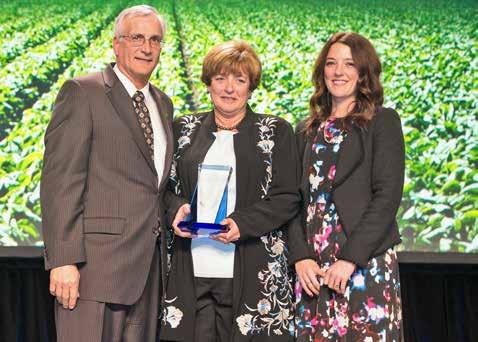
national levels. He served as President and Chairman of both organizations. He was also a dedicated supporter of ASA’s World Soy Foundation and served on the board of the United States Soybean Export Council (USSEC), including one year as board secretary.
During nearly a decade on the ASA Board of Directors, Joslin served five years on Executive Committee, and began his year as ASA president in December 2009.
During his three-year officer cycle with ASA, Joslin spent hundreds of “volunteer” hours working on policy, regulatory and trade issues to benefit soybean farmers.
He was instrumental in developing ASA positions on two farm bills. He was engaged in many legislative efforts, involving such issues as the biodiesel
Joslin was active on the ASA Board for a decade and served as president in 2010.
ASA President ron Moore (left) presents e llen Joslin (center) and Gail Joslin Kelley (right) with rob Joslin’s posthumous Lifetime Achievement Award-Association Focus at the ASA awards banquet in San Antonio.
PHoto: Joe MurPHy
tax incentive, estate taxes and ag appropriations. He also provided strong representation for U.S. soybean farmers on numerous trade issues.
“Through all his work, Rob led with integrity, a deep knowledge of the issues and a vision for the future. He left his mark on the soybean industry and ASA is proud and grateful for his impact,” said ASA President Ron Moore. “Rob was a true leader, forging collaboration and non-partisan relationships and always with a positive outlook and a determination to do his best in every way.” u
The American Soybean Association (ASA) recently signaled its support for an anti-dumping and countervailing duty petition filed by the National Biodiesel Board (NBB). The petition alleges that Argentine and Indonesian companies are flooding the U.S. market with dumped biodiesel — biodiesel sold at less than the cost of production — and subsidized biodiesel in violation of America’s trade laws. Soybean oil remains the primary biodiesel feedstock in the U.S., and the biodiesel industry provides a significant market for surplus soybean oil that is a co-product of protein meal production. ASA President Ron Moore, a soybean farmer from Roseville, Ill., confirmed ASA’s support for the NBB petition in a statement:
“Biodiesel imports from Argentina and Indonesia have flooded the U.S. market in recent years and these imports receive trade and market distorting subsidies in their home countries that provide an unfair advantage over U.S. biodiesel. Soybean farmers have a vested interest in the biodiesel industry, having made substantial investments over the past several decades to establish and build a domestic biodiesel industry and market. We believe an investigation by the Department of Commerce and the International Trade Commission will show that unfair subsidies provided by Argentina and Indonesia are resulting in imports being unlawfully dumped on the U.S. market. We look forward to the appropriate anti-dumping and counter-
vailing duties being imposed to remedy these unfair and unlawful practices.” u

Text “Soybean” to 31313 and enter for a chance to win a $100 Cabela’s gift card and to see how Soybean Rewards can plug you into the latest information driving Ohio’s smartest farms.

The Ohio Soybean Council and soybean checkoff established the Soybean Rewards program to provide Ohio soybean farmers information, research and other resources about yields, premium opportunities, new varieties, disease and pest management, conservation best management practices and more.
www.soybeanrewards.org
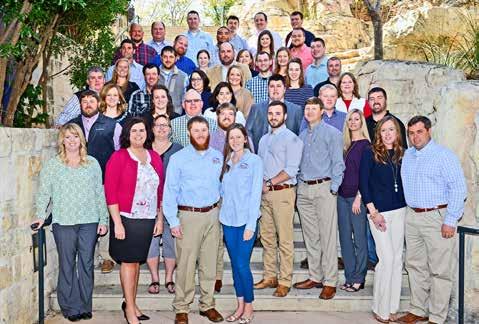
The increasing average age of the U.S. farmer population has been a concern on the radar of many agricultural organizations. To help secure future leadership, several have established programs to make sure the next generation of farmers is connected and engaged with the industry.
“The American Soybean Association (ASA) DuPont Young Leader program has been identifying new and emerging leaders for the soybean industry for more than 30 years,” said ASA President Ron Moore. “We’re grateful to DuPont Pioneer and Dupont for their commitment to the program and helping secure the future of the soybean industry.”
Twenty-eight participants from across the U.S. were selected for this year’s program including Trish Levering from Fredericktown, Ohio. The program focuses on personal and professional development for participants which includes leadership and communication training, information sessions to expand their knowledge of industry issues and workshops to help them strengthen their voice to reach
out to legislators and become leaders in their communities.
Culminating with a program session in conjunction with the Commodity Classic in San Antonio, participants attended sessions on leadership, marketing, current issues updates, held discussions and were recognized at ASA’s annual awards banquet.
“This year produced a remarkable group of young leaders,” said Steve Reno, DuPont Pioneer vice president, business director, U.S. and Canada. “They focused significant energy into taking on the challenges facing our industry. I’m proud of our continued commitment to this program and impressed by the leadership skills already being demonstrated by these young leaders.”
ron Moore, ASA president, trish Levering (oH) and Kevin Diehl, director of regulatory Strategy and Industry Affairs, DuPont Pioneer. trish is receiving a plaque to commemorate her graduation from the program.
The 2017 class of ASA DuPont young leaders continues Phase II of training in San Antonio. PHoto: Joe MurPHy
In addition to being a sales representative with Pioneer and a licensed crop insurance agent, Levering works on the farm with her husband where they grow soybeans and corn and manage a cow calf herd. She is an active member of the agriculture community and has been a long-time member of Farm Bureau, Ohio Soybean Association (OSA), Ohio Corn & Wheat Growers and Ohio Cattleman’s.
Levering has also completed state leadership programs including Ohio Farm Bureau’s AgriPOWER program, and is a part of OSA’s Soy Select. She has served in many roles with her county Farm Bureau — including four years as President — and is serving as co-chair of the Ohio Beef Expo’s Junior Show Committee.
“We are proud to have Trish represent Ohio and are extremely excited to see the leadership she will bring to our organization and the agricultural industry in the future,” said OSA President Todd Hesterman. “She is passionate about the industry and engaged in many roles where she actively contributes to the success of agriculture programs. Young leaders like Trish are exactly what we need to keep the industry thriving.” u
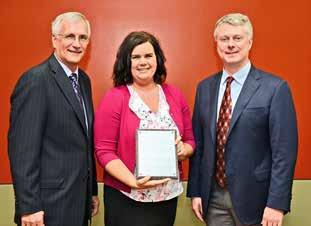
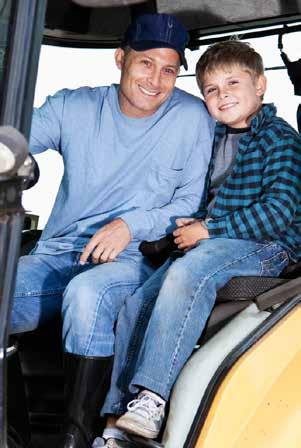
Each quarter, the Ohio Soybean Association and Beck’s Hybrids will select a Young Farm Leader to feature the individual’s leadership, both on and off the farm in Ohio agriculture publications.
Each quarter, the Ohio Soybean Association and Beck’s Hybrids will select a Young Farm Leader to feature the individual’s leadership, both on and off the farm in Ohio agriculture publications.
One of the Beck’s Young Farm Leaders will be selected as the 2016 Beck’s Young Farm Leader of the Year and receive a trip for two ($2,000 value) to the 2017 Commodity Classic in San Antonio, Texas. Beck’s Young Farm Leaders may also be chosen to attend Ohio Soybean Association and/or Beck’s Hybrids leadership training programs, board meetings, events and other relevant activities. To apply or nominate someone, visit www.soyohio.org/becksyoungfarmleader
One of the Beck’s Young Farm Leaders will be selected as the 2017 Beck’s Young Farm Leader of the Year and receive a trip for two ($2,000 value) to the 2018 Commodity Classic in Anaheim, California. Beck’s Young Farm Leaders may also be chosen to attend Ohio Soybean Association and/or Beck’s Hybrids leadership training programs, board meetings, events and other relevant activities.
The Ohio Soybean Association (OSA) has named Kirk Merritt Executive Director of the grassroots policy and member-driven organization. Merritt currently serves as the Executive Director of the Ohio Soybean Council (OSC), which manages soybean checkoff dollars, and will continue in that role.
The announcement follows the departure of Adam Ward, who had served as OSA Executive Director and OSC Director of Marketing and Outreach since 2010. Ward left the organizations to pursue an opportunity at The Ohio State University (OSU) as the Government Affairs Director for the College of Food, Agricultural, and Environmental Sciences.
“We want to thank Adam for his dedication to our organization and his help in raising our level of recognition at the Statehouse and Washington, D.C. We look forward to working with him in his new role,” said Todd Hesterman, OSA President and Henry County soybean farmer. “To build on the progress made, we believe there is no better candidate than Kirk who has already been working with OSA and has done great work for OSC.”
Merritt joined OSC in June 2007 as International Marketing Director and Director of Outreach and Programs for the Ohio Soybean Council Foundation (OSCF). In 2009 he was promoted to Executive Director of both organizations. He has worked closely with the OSC Board of Trustees to advance OSC’s mission of enhancing profit opportunities for Ohio soybean farmers. Prior to the Ohio soybean organizations, Merritt was the Director of the International Trade Division in the Ohio Department of Development leading a team with offices in Ohio and eleven international markets. Kirk holds a B.A. from
“
Technology is advancing and being adopted at a rapid rate. U.S. and international consumer demographics are changing. Legislative priorities and policies are in flux. I am looking forward to the challenge and can’t wait to get started. My first goal for OSA is to continue the good work that was done over the past several years and build on that for the future.
“
–
Kirk Merritt
Manchester University and a M.A. from OSU.
Merritt looks forward to tackling his new role and keeping the missions of all three organizations, OSA, OSC and OSCF, in sync with the growing and changing agricultural industry.
“Agriculture is an extremely exciting industry to be in right now,” said Merritt. “Technology is advancing and being adopted at a rapid rate. U.S. and international consumer demographics are changing. Legislative priorities and policies are in flux. I am looking forward to the challenge and can’t wait to get started. My first goal for OSA is to continue the good work that was done over the past several years and build on that for the future.” u

Kirk Merritt was recently named executive Director of the ohio Soybean Association.


Overseas markets for soybeans, soybean meal and oil, as well as food-grade soybeans, didn’t just open up by themselves. It took years of knocking on doors, telling your story to prospective buyers and inviting customers to visit Ohio. In other words, things your soybean checkoff does very well. To learn more about where your checkoff dollars go, visit soyohio.org.



Each year as winter begins to fade and spring is on the horizon, farmers come together and prepare for a new growing season with educational sessions, association meetings and farmer to farmer networking at the annual Commodity Classic.
The 2017 event held in San Antonio, Texas, was attended by more than 9,000 farmers and advocates who came together in search of new ideas, innovative technology and proven solutions to make their farms more successful. Featuring a trade show with 425 companies and educational sessions with standing-room-only audiences, the event covered topics from the outlook of the ag economy, yield barriers, plant health, sustainability, weed management, weather patterns, plant genetics and much more.
With the pace of innovation continuing to accelerate, Commodity Classic is a great way to see the latest and greatest. While the volume of information may be overwhelming, those who attend leave with a better awareness of the state of the industry and what’s coming up on the horizon.
Dale Minyo, ohio Country Journal/ohio AgNet hosts a panel discussion during the annual ohio breakfast. Pictured on the right is todd Hesterman, ohio Soybean Association President and in the center is ohio & Wheat Association vice President, Jed Bower.

“The Ohio Soybean Council (OSC) and Ohio Soybean Association (OSA) had many farmer-leaders in attendance,” said Kirk Merritt, Executive Director of OSC and OSA. “It’s a terrific opportunity for board members to hear about the most current industry updates, latest management practices, innovation, developments in technology, equipment and take part in policy development.”
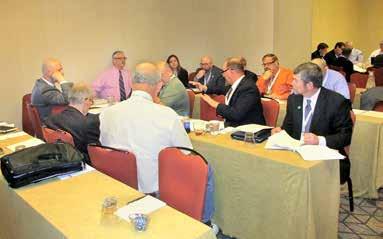
A group of ohio Soybean Association board members meet during the ohio, Indiana and Michigan Delegation Caucus Session to set policy direction for the upcoming year.
Many commodity groups, including the American Soybean Association (ASA), hold policy sessions at Commodity Classic where state leaders and delegates come together to provide input on policies that will shape the organization’s goals and work for the next year.
“We encourage our board members to participate to shape and have input on policy development at a national level,” said Merritt. “Commodity Classic is the policy convention for the ASA and this year with the Farm Bill coming up for review, a new administration in D.C., and changes in Congress it’s an extremely important role our members can play in influencing policy.”
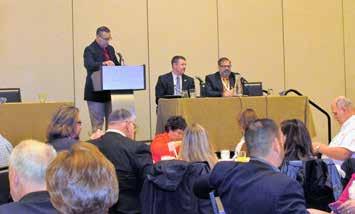
Trending topics this year included an emphasis on maintaining the safety net for agriculture and sufficient levels of crop insurance for growers in the
Farm Bill. Trade was also a prominent issue and making sure Congress maintains and expands trade opportunities that the soybean industry so heavily relies on.
Commodity Classic is also a unique platform for our farmer-leaders to network with other growers from Ohio. OSC along with Ohio Corn and Wheat Growers and Nationwide Insurance hosted a breakfast for the 150 participants from Ohio allowing for interaction and discussion between growers and commodity group leaders about what the groups are doing on behalf of farmers.
An additional highlight this year for Ohio farmers was the recognition of John Motter for being the first soybean farmer from Ohio to be elected as Chairman of the United Soybean Board (USB). USB has been around since the checkoff program was put in place in 1991. Motter was elected as Chairman of the Board by the 73 farmer members from across the country making it a tremendous honor for Motter as well as Ohio. u
The 2017 Ohio Pork Producers Symposium was held on Feb. 15 at the Columbus Crowne Plaza North as a part of the 2017 Ohio Pork Congress where the Ohio Soybean Council (OSC) received the “2016 Friends of the Ohio Pork Industry award” from the Ohio Pork Council (OPC).
The award recognizes an individual, organization or company that has made a substantial impact on OPC in the given year. The work of OPC is made possible by the many generous supporters in the community. Without supporters and contributors, OPC would not have the ability to operate the way it does today. In an effort to recognize and thank supporters, OPC established the Friends of the Ohio Pork Industry award.
“We appreciate OSC’s partnership with us, as we work together to develop tools, and resources that help share the story of modern agriculture,” said Rich Deaton, president of OPC. “We are truly grateful,
The USDA’s Census of Agriculture is completed every five years with 2017 being the current data collection year. Statistics gathered paint a picture of the characteristics of American farmers and the scope of their operations.
The last census, completed in 2012 showed that while the largest sector of farmers continues to age, there are fewer farmers joining the field. From 1982–2012 the average age of a farmer rose from 50 to 58-years-old and in the last five years the number of new farmers has dropped by 25 percent.
While the age of farmers might suggest that fewer people want to get involved in agriculture, there are many factors that discourage young people from staying on or returning to the farm. Increases in land
and are pleased to honor them by recognizing OSC as the 2016 Friends of Ohio Pork Industry recipient.”
In addition to creating new tools and resources to better promote pork products and educate the public about the pork industry, OPC has been able to participate in more outreach programs, including food festivals and advertisements because of OSC’s support.
“We are honored to receive this recognition from our friends at OPC,” said Steve Reinhard, OSC board member and Crawford County soybean farmer. “We are really proud to support OPC and their efforts. Pork is a top customer of soybeans and we hope to continue this relationship to expand the demand for soybeans and pork both here at home and internationally.” u

Kirk Merritt, oSC executive Director (left), rich Deaton, oPC President (center) and Steve reinhard, oSC board member (right) at the 2017 ohio Professional Pork Producers Symposium. Deaton presented oSC the“2016 Friends of the ohio Pork Industry award.”
prices and input costs have not only made it difficult for new farmers to get started, but also create a challenge for family farms as the next generation seeks off-farm employment because the farm cannot support multiple families or generations or for health insurance and other benefits.
Statistics from the census have been one of the driving factors behind beginning farmer and rancher benefits that were included in the 2014 Farm Bill; three years later, the 2017 census should provide some insight into whether those programs are accomplishing the goal of easing the financial burdens and opening opportunities for new farmers.
While it often seems disheartening that young people are struggling to begin or
return to farming, challenging times have their benefits. As young farmers look for ways to make a living on the farm they are turning to diversification in the form of multiple sectors of farm income, or niche markets that can be sold for premium prices.
Other statistics of interest are the number of women and minority farmers as principal operators, the number of farmers with internet access as technology continues to plow forward and the number of operators who work off the farm.
Agriculture is an ever-changing industry and the census provides a map of where the industry has been and a glimpse of where it may be going.
For more information, visit www.uSDA.gov. u




Ohio soybean farmers consistently rank state and federal regulation as their top concern.
The Ohio Soybean Association (OSA) provides leadership for Ohio’s soybean farmers in promoting effective policies and legislation. OSA represents its members at both the state and federal levels, and works cooperatively with its national affiliate, the American Soybean Association. Soybean checkoff dollars cannot be used for lobbying and legislative activities. That’s why your OSA membership is vital to making the soybean industry in Ohio successful and profitable for years to come.






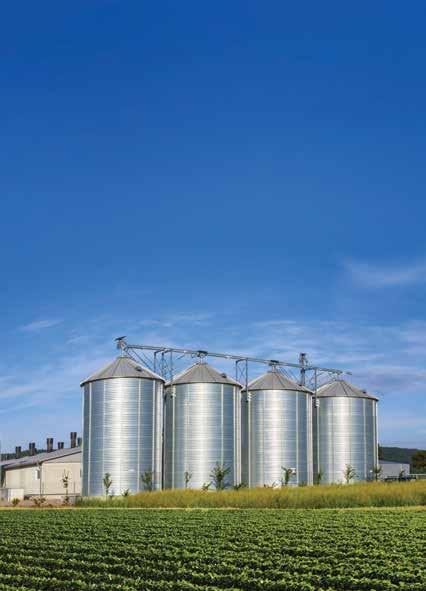
The Ohio Soybean Council was founded in 1991 to manage the Soybean Research and Promotion Program, commonly referred to as the soybean checkoff. Soybean farmers pay one half of one percent of the bushel price to the soybean checkoff when they sell soybeans. Half is sent to the United Soybean Board and half is invested right here in Ohio in soybean production research, marketing and promotion, new product development and education to maximize profit opportunities for soybean farmers.
While many Ohioans enjoyed the mild temperatures and limited snow during the past winter, there may be subtle consequences for farmers. Aside from what the unusual winter months contribute to an already unpredictable weather pattern and soil, there are a few things soybean producers should be keeping a closer eye on this growing season.
According to soybean agronomist, Laura Lindsey, at The Ohio State University, mild temperatures through the winter months create an atmosphere that favors survival of disease on plant residue.
“Ohio had a really mild winter overall; the biggest thing to watch for is disease,” said Lindsey. “The biggest one to keep an eye out for is frog eye leaf spot. Traditionally we’ve thought of it as a southern disease, but with a mild Ohio winter we see it frequently
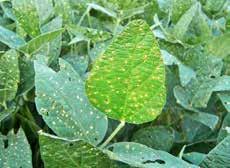
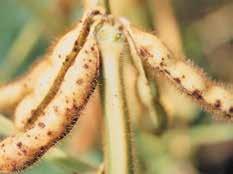
in our research, especially in the southern part of the state.”
Frog eye leaf spot can be seen as early as the R1 growth stage, typically occurring around the first week of July, but may also surface as late as the R3 or R4 growth stage. Lesions will appear as small gray spots with reddish-brown or purple borders and the underside of leaves will show brown spots with tiny hairs produced by the fungus. Younger soybeans are more susceptible, especially before flowering and depending on the severity of the disease a fungicide may be warranted to prevent further damage to foliage.
Taking a proactive approach includes having a plan to scout fields at times when they are most susceptible to disease. Crop rotation in the year following high levels of frog eye leaf spot also plays a critical role in prevention of an epidemic and should be followed by resistant varieties. u
As Ohio livestock farmers, taking care of the environment is a top priority. The Ohio Livestock Environmental Assurance Program (LEAP) is a voluntary program to help Ohio’s livestock farms take a hands-on approach in protecting the land, air and water on and around farms.
The program was founded in 1997, and previously existed only in print. The Ohio Livestock Coalition recently launched the program online to make information more easily accessible to farmers throughout the state of Ohio. As a member of the Ohio Livestock Coalition, the Ohio Soybean Council supports the program and
encourages all Ohio soybean farmers to visit the website at https://ohleap.org
LEAP is available to all Ohio livestock farmers who are interested in taking a proactive approach in protecting Ohio farm lands, and creating an environment in which Ohio's farm community can prosper and grow. LEAP helps farmers identify and address key management issues affecting environmental quality by providing helpful evaluation tools and resources.
If you own a farm, use manure in your operations, have an issue on your farm, or are looking to expand visit ohleap.org to find helpful tools and current legislation. u

The Ohio Soybean Council Foundation (OSCF) recently announced the scholarship recipients for the 2017–2018 academic year. This is the tenth year for the OSCF Scholarship Program, which was created to encourage undergraduate students to pursue degrees in one of the many academic fields that support the future of the soybean industry including agriculture, business, communication, economics, education, science and technology, as well as to support ongoing graduate-level research. Since 2008, the OSCF scholarship program has awarded $266,000 in scholarship funds to 65 students studying agriculture or a related field at Ohio colleges or universities.
Undergraduate scholarships of $3,000 each were awarded to Christine Balint, Madison Flasco, Cody McClain, Abby
Christine Balint of Huron, Ohio is a Junior at The Ohio State University (OSU) studying Agriscience Education.
Madison Flasco of Copley, Ohio is a Junior at Otterbein University studying Biology and Mathematics.
Cody McClain of Nevada, Ohio is a Sophomore at OSU studying Agriscience Education.
Abby Motter of Mansfield, Ohio is a Sophomore at OSU studying Agriscience Education.
Anna Schmenk of Leipsic, Ohio is a Junior at OSU studying Food Science and Technology.
Mikayla Storck of New Carlisle, Ohio is a Sophomore at OSU studying Agribusiness and Applied Economics.
Motter, Anna Schmenk and Mikayla Storck. The annual $3,000 Farmer, Lumpe + McClelland (FLM) Scholarship, awarded to students in the field of agriculture communications or business, was awarded to Brianna Gwirtz. The annual $5,000 Bhima Vijayendran Scholarship, named in honor of a Battelle research scientist who has made tremendous contributions to the soybean industry, was awarded to Rachel Krebs. The Robinson W. Joslin scholarship was awarded to Matthew Klopfenstein. New this year, the annual $3,000 scholarship was created to honor a long-time leader in the soybean industry both in Ohio and nationally, who passed away in May of 2016.
Graduate scholarships of $5,000 were awarded to John Craft and Kelsey Scott. Graduate scholarships of $2,500 were awarded to Eric Dean and Sukhmanjot Kaur.
Brianna Gwirtz of Shelby, Ohio is a Junior at OSU studying Agricultural Communication.
Rachel Krebs of Gahanna, Ohio is a Junior at the University of Dayton studying Chemical Engineering.
Matthew Klopfenstein of Haviland, Ohio is a Sophomore at OSU studying Agricultural Engineering.
John Craft of Columbus, Ohio is pursuing his Masters in Agronomy at OSU. His research is to determine the effect on soybean growth, development, and harvest parameters from a foliar nitrogen application of CoRoN 28 Ag during pod development (R3 growth stage).
Kelsey Scott of Wooster, Ohio is pursuing her Masters in Plant Pathology at OSU. Her
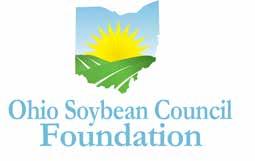
“Congratulations to the 2017–2018 OSCF scholarship recipients,” said Bill Bateson, OSC board member, soybean farmer from Hancock County and scholarship selection committee member. “We are very pleased with the level of academic achievement the scholarship winners have already achieved in the field of agriculture. There is no doubt that these students will benefit the soybean industry in Ohio.” u
research focuses on satisfying both the fungicide seed treatment and the genetic resistance aspects of Pythium seed and root rot management.
Eric Dean of Wooster, Ohio is pursuing his Masters in Horticulture and Crop Science at OSU. His research involves optimization of soybean seed development and the potential to shorten seed-specific gene evaluations.
Sukhmanjot Kaur of Akron, Ohio is pursuing her Ph.D. in Polymer Science at the University of Akron. She is exploring the use of soybean oil for synthesizing adhesives applicable for wet and humid environments such as underwater construction or adhesives in biomedical sciences
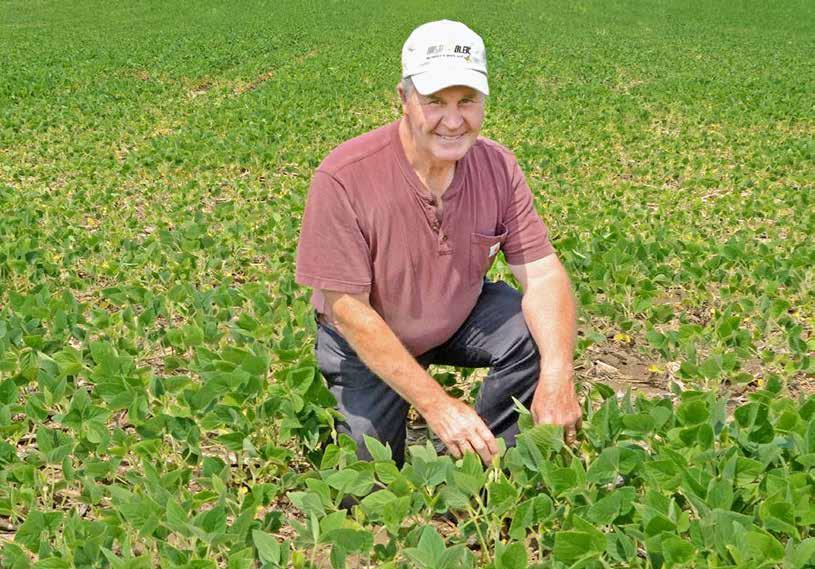
In a time when technology seems to be changing daily, farmers are overwhelmed with options for data collection, variable rate seeding, prescription applications and the introduction of autonomous equipment. Moreover, agriculture has never been a one size fits all industry, so each season, farmers are trying to make the best decision for their situation and make the year successful. At the same time that customers are demanding sustainability from producers, with commodity prices falling in recent years, producers are looking for ways to cut their input cost. Fortunately, there are ways for farmers to accomplish both goals by embracing cover crops and precision agriculture technologies. In Preble County, Keith Kemp and Lane Osswald are two
examples of how conservation and cutting costs can go hand in hand.
Kemp, an ex-officio board member for the Ohio Soybean Council, believes the more efficient his farm in West Manchester, Ohio, is today, the more profitable his operation will be down the road. Beginning his foray into no-till 30 years ago, Kemp identifies clear benefits of increased earthworm populations, microbes and other organisms that bring the soil back to life, digest residue and increase fertility.
“We manage our data very closely,” said Kemp. “We’ve been utilizing precision ag for five years now and it’s working out great. It’s amazing the amount of seed and chemicals you can save by not overapplying or overlapping.”
Keith Kemp analyzes his soybeans at various stages through the growing season to make sure they are on track for success.
“It takes a lot of the stress off the operator — at the end of the day you’re not near as tired and you’re doing a better job farming and know everything that’s going on. It makes farming fun,” said Kemp.
While Kemp jumped into precision ag when commodity prices were higher, he encourages other producers to look at options for their farm. With today’s prices, it may take them an extra year or two for new technology costs to pay off, but the efficiency will save money in the end.
“We manage our data very closely. We’ve been utilizing precision ag for five years now and it’s working out great. It’s amazing the amount of seed and chemicals you can save by not overapplying or overlapping.” – Keith Kemp
At Osswald’s farm in Eldorado, it’s the next generation and his bottom line that help drive decisions. Along with being a certified crop advisor since 1997, he has been utilizing cover crops for more than 20 years.
Serving on the Ohio Farm Bureau Board of Trustees, Osswald knows the interest consumers have in the practices farmers use; he also knows the industry needs to make sure they do the right things to set the next generation up for success and is hopeful his son and nephews will be the next ones to take interest in the family operation.
“We’ve used a variety of cover crops and sometimes it just comes down to economics. We’ve used hairy vetch, and cereal rye, but have found wheat is affordable, available and achieves our goals by putting something living on the ground to keep residue from washing away,” said Osswald. “We have farms that we bought in early 90s where we quit tilling and started cover cropping and the yields have improved.”
He also believes it helps preserve soil moisture during the growing season with his cover crop fields looking better amidst long, hot dry spells than area fields that utilize tillage. While he hasn’t made the jump to variable rate seeding, Osswald utilizes the data from regular grid sampling that allows for variable rate application of fertilizer.
“I know looking at the pH and being able to apply according for each zone saved us tremendously on lime application. The data allows us to be better stewards of the nutrients,” said Osswald. “There are times where we’re still applying the same amount, but now we’re applying it to the right areas, instead of a blanket application, so we’re giving our crops just what they need to thrive.”
Osswald also knows the data gives him the knowledge he needs to make decisions in tough economic times. Knowing the levels of nutrients in the soil allows him to make cuts when needed without shorting the crops of essential nutrients.
Practices that can help farmers take care of the land and achieve an edge on
profitability are something that both consumers and producers can get behind.
“Precision ag is also good for water quality and accountability — we have the data to back up everything we do and sustainability is something consumers associate with,” said Kemp. “We have to explain what we’re doing to be sustainable. In Europe, there is a sustainability protocol to sell there, consumers are showing a demand for it and when there is demand or a premium price that will drive it even more.” u
Lane osswald checks out the field cover and soil conditions to get insight on his fields before spring planting.
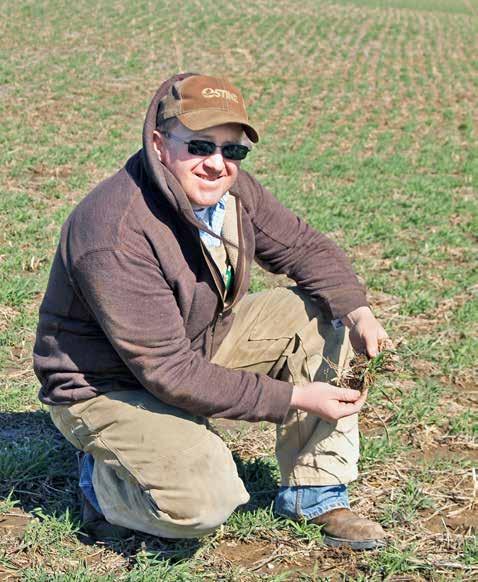
Change is inevitable to stay relevant, especially now as agriculture experiences a surge of technological innovation that will undoubtedly revolutionize the industry. At the same time, the average age of an Ohio farmer continues to rise and a new generation is coming to the helm with new ideas and expectations.
Ohio farmers will need every tool available to them to manage risk and make the best, most costefficient decisions for their farm in the coming years. With that in mind, the Ohio Soybean Council (OSC) Board of Trustees, who are responsible for managing state soybean checkoff dollars, recently adopted a new strategic plan that will refocus its efforts.
“We are not changing the drive we’ve always had to serve Ohio soybean farmers, but we are modernizing our approach to planning,” said Terry McClure, OSC chairman and Paulding County soybean farmer. “With this change, the OSC farmer-leaders have clarified the mission and vision for OSC and put a laser focus on the goals that will push our organization to the next level.”
The national soybean checkoff was created in 1991 with the passage of the
Farm Bill. Half of one percent of the bushel price at the time of sale is collected from all soybean farmers in the U.S. Half of the collected funds go to the national United Soybean Board and the other half stays with the designated state soybean board. For Ohio, that designated board is OSC.
growth of the biodiesel industry, new soy-based products available on the marketplace, and strong relationships with international customers. The Ohio Soybean Council has been the recipient of numerous education and innovation awards, including seven R&D 100 awards for various soybased technologies.
While the organization has had many successes, leadership still recognizes the need to constantly rise to the challenge of doing better and accomplishing even more.
“Our farmerleaders have worked hard to streamline our strategic planning process and focus our efforts to invest soybean checkoff dollars wisely,” said Kirk Merritt, OSC Executive Director.
Since its beginning, OSC has been farmer-led by farmers elected by their peers and focused on improving the short and long-term profitability of the industry here in Ohio. By investing checkoff dollars in research, development, marketing and education, OSC always seeks a return for farmers’ investment.
Some of the most recognized checkoff successes have been the
“I look forward to working with them to fully implement our new plan and showing Ohio soybean farmers what we’re doing on their behalf.”
In addition to an updated and more streamlined strategic plan, OSC has adopted a new logo that sharpens the organization’s image to both farmers and other industry stakeholders. The Ohio Soybean Association (OSA) also adopted a new logo that aims to highlight the legislative aspect of the organization. u

Invest soybean checkoff funds to maximize the value of soybeans and increase profit opportunities for Ohio farmers
VISION
Inspire continuous innovation of the soybean industry for future generations of Ohio soybean farmers
Create a preference with buyers and promote efficient delivery syste ms that lead to increased sales of Ohio soybeans and soybean -derived products
Objectives:
§ Increase domestic usage of products derived from soybean oil and meal
§ Increase market access for Ohio soybeans and soybean-derived products
§ Increase customer awareness of the value and preference for high quality Ohio soybeans

§ Increase on-farm infrastructure resources for farmers and support transportation industry partnerships
Support agronomic improvements, technological advancements, and the development of new soybean products
Objectives:
§ Develop new soy-based products and applications
§ Develop new soybean traits and technologies that increase y ield and create specialty product opportunities
§ Develop technologies and practices that support Ohio soybean farmers’ commitment to environmental stewardship
Develop and deliver information to soybean farmers, educate t he next generation about modern agriculture, and build trust among key target audiences
Objectives:
§ Increase trust and understanding of agriculture among Ohio teachers and students
§ Increase awareness and value of checkoff investments among Ohio soybean farmers and industry partners


§ Increase awareness among key stakeholders of the impact and value of the Ohio soybean industry
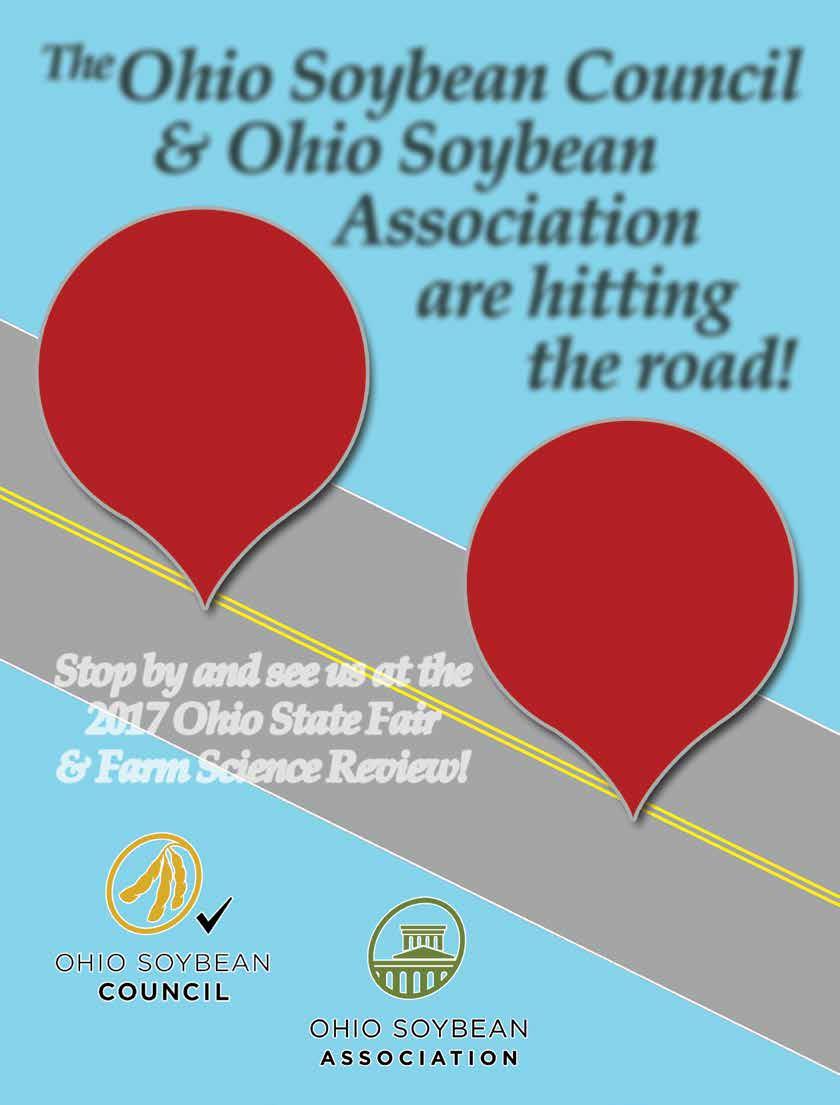


SEEDS/PODS:
n Corn earworm
n Stink bug complex (Brown, Brown marmorated, Green, Redbanded, Southern green)
n Grasshopper
n Bean leaf beetle
SAP/PHLOEM:
n Soybean aphid
n Kudzu bug
ROOT/NODULE:
n Wireworm
n Bean nodule y
n Grubs
LEAVES:
n Soybean looper
n Green cloverworm
n Bean leaf beetle
n Velvetbean caterpillar
n Fall armyworm
n Japanese beetle
n Spider mites
n Grasshopper
STEM/PETIOLES:
n Cutworms
n Three cornered alfalfa hopper
n Lesser corn stalk borer
n Dectes stem borer
n Kudzu bug
This is a list of some of the more common soybean insect pests and is not comprehensive. To find out more about these and other insect pests, visit UnitedSoybean.org.
